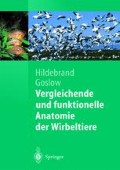Zusammenfassung
Alle Zellen der Vertebraten verbrauchen Sauerstoff und geben Kohlendioxid ab. Der einzige Weg, über den these Gase in die Gewebe und aus ihnen bewegt werden können, ist die Diffusion. Da die Vertebraten viel zu groß sind, als dass jede Zelle direkt mit der Umgebung interagieren könnte, sind bestimmte respiratorische Organe darauf spezialisiert, den notwendigen Gasaustausch mit der Umgebung für den gesamten Körper zu bewerkstelligen. Ein solcher Austausch wird äußere Atmung genannt und kann an bestimmten Embryonalhüllen, an der Hautoberfläche, in Kiemen, in Lungen oder manchmal auch an anderer Stelle stattfinden. Sauerstoff und Kohlendioxid werden zwischen den Atmungsorganen und anderen Geweben durch das Blutgefäßsystem transportiert. Sie werden dann in den Geweben über die entsprechenden Kapillarsysteme ausgetauscht, ein Vorgang, der innere Atmung genannt wird.
Access this chapter
Tax calculation will be finalised at checkout
Purchases are for personal use only
Preview
Unable to display preview. Download preview PDF.
Literatur
Brainerd EL, Ditelberg JS, Bramble DM (1993) Lung ventilation in salamanders and the evolution of vertebrate airbreathing mechanisms. Biol J Linnean Soc 49:163–183
Brainerd EL, Liem KF, Samper CT (1989) Air ventilation by recoil aspiration in polypterid fish. Science 246:1593–1595
Bramble DM, Carrier DR (1983) Running and breathing in mammals. Science 219:251–256
Bramble DM, Jenkins FA (1993) Mammalian locomotor-respiratory integration: implications for diaphragmatic and pulmonary design. Science 262:235–240
Coates MI, Clack JA (1991) Fish-like gills and breathing in the earliest known tetrapod. Nature 352:234–236
Demski LS, Gerald JW, Popper AN (1973) Central and peripheral mechanisms of teleost sound production. Am Zool 13:1141–1167
Duncker HR (1971) The lung air sac system of birds: a contribution of the functional anatomy of the respiratory apparatus. Ergeb Anat Entwicklungsgesch 45(6). Sehr gute Abdeckung des Themas und hervorragende Abbildungen
Duncker HR (1989) Structural and functional integration across the reptile-bird transition: locomotor and respiratory systems. In: Wake DB, Roth G (eds) Complex organismal functions: Integration and evolution in vertebrates. Wiley, New York, pp 147–169
Farmer CG, Carrier DR (2000) Pelvic aspiration in the American alligator (Alligator mississippiensis). J Exp Biol 203:1679–1687
Feder ME, Burggren WW (1985) Cutaneous gas exchange in vertebrates: design, patterns, control and implications. Biol Rev 60:1–45
Feder ME, Burggren WW (1985) Skin breathing in vertebrates. Sci Am 253:126–142
Frazer Sissom DE, Rice DA (1991) How cats purr. J Zool London 223:67–78
Gaunt AS (ed) (1973) Vertebrate sound production. Am Zool 13:1139–1255
Henry RP, Smatresk NJ (symposium organizers) (1994) Current perspectives on the evolution, ecology, and comparative physiology of bimodal breathing. Am Zool 34:117–299. Die Beiträge beschäftigen sich mit verschiedenen strukturellen und funktionellen Anpassungen der Atmung bei Übergängen von Wasser-zu Luftatmung bei Fischen und Amphibien
Houlihan DF, Rankin JC, Shuttleworth TJ (1982) Gills. Cambridge Univ Press, New York
Hughes GM, Morgan M (1973) The structure of fish gills in relation to their respiratory function. Biol Rev 48:419–475
Jones FRH, Marshall NB (1953) The structure and functions of the teleost swim bladder. Biol Rev 28:16–83. Umfassend
King AS, McLelland J (eds) (1989) Form and function in birds, vol 4. Academic Press, New York. Der gesamte Band befasst sich mit Atmung
Laurent P (1982) Structure of vertebrate gills. In: Houlihan DF et al (eds) Gills. Cambridge Univ Press, New York, pp 25–43
Liem KF (1985) Ventilation. In: Hildebrand M et al (eds) Functional vertebrate morphology. Harvard Univ Press, Cambridge/MA, pp 185–209
Liem KF (1987) Functional design of the air ventilation apparatus and overland excursions by teleosts. Fieldiana Zool NS 37:1–29
Liem KF (1988) Form and function of lungs: The evolution of air breathing mechanisms Am Zool 28:739–759
Liem KF (1989) Respiratory gas bladders in teleosts: Functional conservatism and morphological diversity. Am Zool 29:333–352
Maina JN (1998) The gas exchangers: Structure, function and evolution of the respiratory processes. Springer, Berlin Heidelberg New York. Ein verständliches interdisziplinäres Nachschlagewerk für das Hauptstudium. Umfangreiches Literaturverzeichnis
Maina JN (2000) Comparative respiratory morphology: Themes and principles in the design and construction of the gas exchangers. Anat Rec (New Anat) 261:25–44. Eine breite Übersicht über die Faktoren, die zur Evolution der Atmungsmechanismen der Tiere beitragen; Vertebraten werden ausführlich behandelt
McLaughlin RF, Tyler WS, Canada RO (1961) A study of the subgross pulmonary anatomy in various mammals. Am J Anat 108:149–158
Owerkowicz T et al (1999) Contribution of gular pumping to lung ventilation in monitor lizards. Science 284:1661–1663. Zeigt den effektiven Gebrauch von Röntgenvideographie, um das Ausmaß und den Zeitverlauf der Luftaufnahme durch den Mund während der Fortbewegung und den Bezug zum Sauerstoffverbrauch zu zeigen
Perry SF (1983) Reptilian lungs: Functional anatomy and evolution. Adv Anat Embryol Cell Biol 79:1–81
Perry SF (1998) Lungs: Comparative anatomy, functional morphology and evolution. In: Gans C, Gaunt AS (eds) Biology of the reptilia, vol 2. Academic Press, New York, pp 1–92
Powell FL (2000) Respiration. In: Whittow GC (ed) Sturkies Avian Physiology, 5th ed. Academic Press, San Diego, pp 233–264
Randall DJ et al (1981) The evolution of air breathing in vertebrates. Cambridge Univ Press, Cambridge
Schmidt-Nielsen K (1972) How animals work. Cambridge Univ Press, New York. Behandelt Atmung, Thermoregulation und Gegenstromaustausch
Sellers TJ (ed) (1987) Bird respiration, vol 1. CRC Press, Boca Raton/FL
Simons RS, Bennett WO, Brainerd EL (2000) Mechanics of lung ventilation in a post-metamorphic salamander, Ambystoma tigrinum. J Exp Biol 203:1081–1092
Vitalis TZ, Shelton G (1990) Breathing in Rana pipiens: The mechanism of ventilation. J Exp Biol 154:537–556
Wake MH (1990) The evolution of integration of biological systems: An evolutionary perspective through studies on cells, tissues, and organs. Am Zool 30:897–906. Diskutiert die Verbindung zwischen Atmungs-und Fortbewegungssystem
Wang N et al (1992) An aerodynamic valve in the avian primary bronchus. J Exp Zool 262:441–445
Wood SC et al (1992) Physiological adaptations in vertebrates: Respiration, circulation, and metabolism. Marcel Dekker, New York
Author information
Authors and Affiliations
Rights and permissions
Copyright information
© 2004 Springer-Verlag Berlin Heidelberg
About this chapter
Cite this chapter
Hildebrand, M., Goslow, G.E. (2004). Atmungssystem und Schwimmblase. In: Vergleichende und funktionelle Anatomie der Wirbeltiere. Springer-Lehrbuch. Springer, Berlin, Heidelberg. https://doi.org/10.1007/978-3-642-18951-7_13
Download citation
DOI: https://doi.org/10.1007/978-3-642-18951-7_13
Publisher Name: Springer, Berlin, Heidelberg
Print ISBN: 978-3-642-62375-2
Online ISBN: 978-3-642-18951-7
eBook Packages: Springer Book Archive

